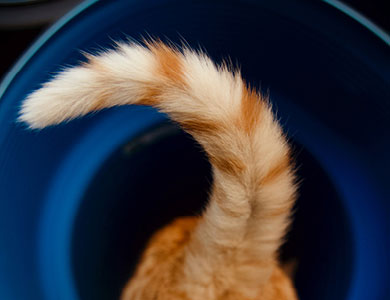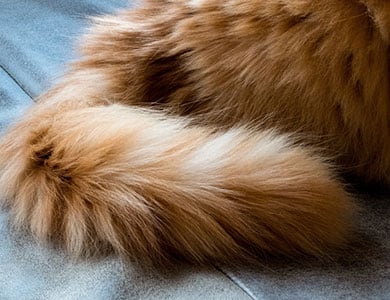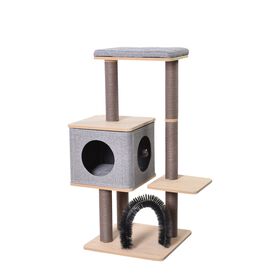Some animals, like horses, use their tails as fly swatters. Others, like monkeys and marsupials, use their tails as an extra hand. Still others, like fish, use their tails as a means of locomotion, while birds use them as rudders. But what about cats? What role do their tails play?
You don't have to be a veterinarian to know that the primary function of a cat's tail is to help the cat keep its balance when performing its many acrobatics. You also know that the tail can provide you with very practical information about your cat's emotional state. For example, a tail straight in the air often means that the cat is happy. However, if the tail is in the air but fluffed up, it may be wise to keep your distance.
That said, what does the curve at the end of the tail that resembles a question mark mean? What is your cat trying to tell you when it flicks its tail? What about cats without tails? Do they have more trouble balancing? Are they misunderstood by other cats? There's so much to learn about cats' tails, so let's get started.

A tightrope walker’s pole
Cats use their tails the same way circus performers use poles or their outstretched arms to keep their balance while walking on a steel wire. If high-wire performers can use their arms, which have only three points of flexion, to keep their balance, imagine just how precise a cat's balance must be, given the 18 to 23 points of flexion in the caudal vertebrae of the tail.
Cats' tails are so effective that they almost always allow cats to land on their feet when they fall. This righting reflex, which largely depends on the tail, helps the cat move its body. Interestingly, statistics show that cats that fall from the third or fourth floor injure themselves more often than cats that fall from the seventh or eighth floor. Although science cannot really explain why, it is suspected that the longer the fall, the more a cat has time to adopt a flying squirrel position, and use its legs and body like a parachute. In fact, a cat needs a height of at least one and a half metres to successfully land on its four feet. It is also believed that an extended fall allows a cat to use its tail to make precise adjustments so that it carefully lands on all four feet and distributes the shock of the fall equally over its entire body, thereby dissipating the kinetic energy to avoid injury.

A communication tool
It's no great secret that cats use their tails to communicate. In fact, animal care professionals very quickly learn to observe a cat's tail to determine its emotional state. Although you should never rely on just one thing when trying to decode a cat's language, the tail is undoubtedly the most obvious and simplest to analyze. Let's take a closer look at its various positions.
- Tail in the air: There are only two possible interpretations. If the cat is calm and relaxed, the cat is happy. There may be a small curve at the end of the tail in the shape of a question mark, which means that your cat is happy and curious. Also, a flicking tail indicates a great deal of positive anticipation. However, if a cat is standing high on its legs and has a hunched up posture, with its head drawn into its shoulders and its back curved, it is frightened and ready to defend itself. A cat in that position is saying: "I'm really scared. If you come any closer, you'll definitely pay the price."
- Tail along the body: Once again, there are two possible interpretations. If the cat is calm and relaxed, with its paws tucked under its body, it is resting. However, if the cat is tense, with its eyes wide open and its head drawn into its shoulders, or recoiled, with its body flat to the ground, it is scared. It may even have its tail between its legs, in which case it is really scared.
- Tail pointing to the ground: The tail in this position is often accompanied by a flicking motion. A cat that is high on its legs, with its back slightly curved and its head pointing forward, is in an assertive position, often adopted when confronting another cat.
- Flicking tail: Once again, there are two possible interpretations. If a cat is low to the ground, staring at a toy or prey, wiggling its rear end back and forth, the flicking tail indicates excitement during play or hunting. However, if the flicking is irregular or jerky, and the cat seems tense, it may be saying: "I'm really irritated by what's going on right now." The more distinct and jerky the flicking, the greater the cat's irritation. When you see a cat flicking its tail, you should stop what you're doing or remove the item that is causing the irritation. It is often the first warning sign that a cat is annoyed with being petted, for example, even if it was purring and seemed to be enjoying it a few seconds earlier. You should definitely take this sign seriously and not assume that it will pass or that the cat will get over it. A flicking tail signals that, if the annoyance continues, the cat could move on to the next warning sign, namely scratching or biting.
- Tail in a "U" shape: You often see the tails of big wild cats on television approaching their prey with their tails in a "U" shape. This indicates that the animal is hunting.
- Tail in an inverted "U" shape. This is typical of playing kittens, taking three sideways hops to initiate play time.
- Tail pointing to the back: Once again, this is often typical of kittens playing together.
Cats never bluff with their body language. Learning how to decode your cat's tail signals will tell you everything you need to know about your cat's emotional state and may prevent difficulties with cats that you don't know.

Is a tail essential?
What about cats without tails? Are they considered disabled? The answer is no. Some cat breeds, such as the Manx for example, are born without tail. Tailless cats like this, or with the highland lynx or one of the more ancient breeds, the Japanese bobtail, are just as agile. Most of these breeds have more muscle definition than most other breeds, especially around the legs and chest. This strength makes up for the loss of stabilizing force in the tail.
Disabled cats that lose their tail in an accident often adapt quickly to their condition, even though it can have a long-term effect on their musculoskeletal structure, and could cause premature health problems, such as arthritis.
You might wonder whether other cats are able to understand a tailless cat just as easily. Firstly, although cats do not voluntarily communicate with their body, they may very likely be able to interpret body signals in the same way we do. If a cat is missing a tail, other cats will simply do what we do and rely on other signals, such as the eyes, ears and body position. What about in the case of the highland lynx, which has no tail and small ears that curl backward? Isn't it difficult to interpret that breed's body language? It can be. As we have all experienced during the pandemic, it can sometimes be difficult to clearly understand what someone is saying when elements that normally help provide clear communication, such as seeing the lips of the person who's speaking, are missing. That is why the tail is a key element of communication for cats.
Now that you know a lot more about a cat's tail, it's up to you to decode everything that your cat is trying to tell you!





